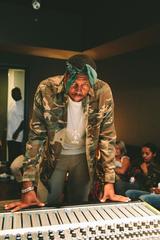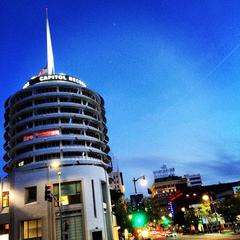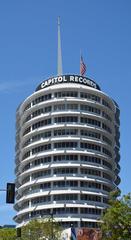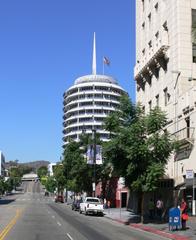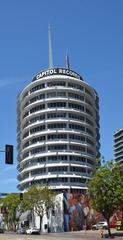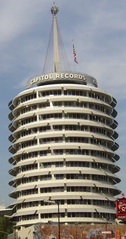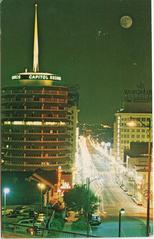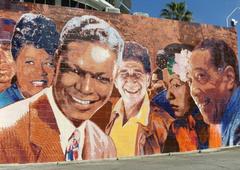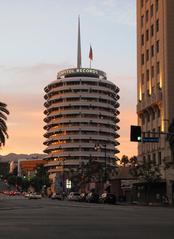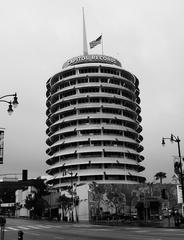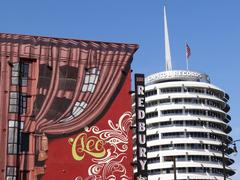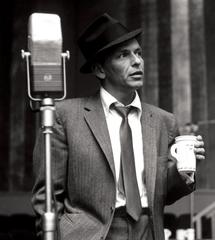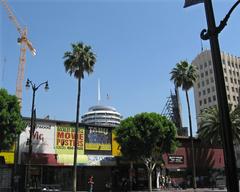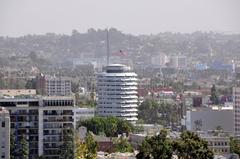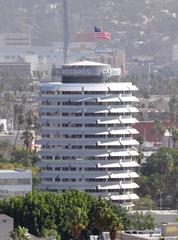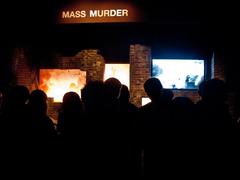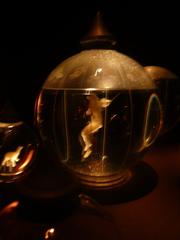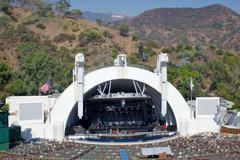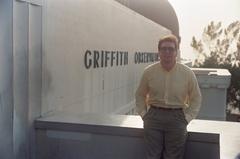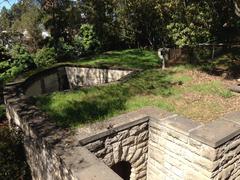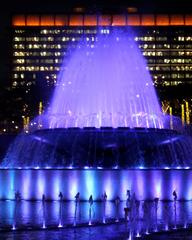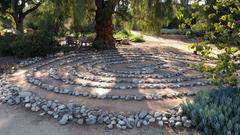
Comprehensive Guide to Visiting Capitol Records Building, Los Angeles, United States
Date: 23/07/2024
Introduction
Nestled in the heart of Hollywood, Los Angeles, the Capitol Records Building stands as a beacon of architectural innovation and a testament to the rich musical heritage of the city. Completed in 1956 and designed by architect Welton Becket, this iconic structure, also known as the “House That Nat Built,” features a unique circular design resembling a stack of vinyl records. This design is not only a nod to the music industry but also serves as a symbol of Los Angeles’ vibrant cultural landscape (Los Angeles Conservancy). Over the years, the Capitol Records Building has played a pivotal role in the music industry, hosting recordings by legendary artists such as Frank Sinatra, The Beatles, and The Beach Boys. Its state-of-the-art studios, designed by Les Paul, have set the standard for acoustic excellence (Architectural Digest). As a designated Los Angeles Historic-Cultural Monument, the building continues to inspire and captivate visitors with its historical significance and ongoing influence in the entertainment industry (Los Angeles Department of City Planning). Whether you are a music enthusiast, a history buff, or simply a curious traveler, this comprehensive guide will provide you with all the essential information you need for a memorable visit to the Capitol Records Building.
Table of Contents
- Introduction
- History of the Capitol Records Building
- Visitor Information
- Visitor Tips for Capitol Records Building
- Conclusion
- References
History of the Capitol Records Building
Origins and Construction
The Capitol Records Building was conceived in the early 1950s. Commissioned by Capitol Records, a major American record label founded in 1942 by Johnny Mercer, Buddy DeSylva, and Glenn Wallichs, the building’s construction began in 1955 and was completed in April 1956. Designed by architect Welton Becket, the structure is renowned for its unique circular design, resembling a stack of vinyl records on a turntable. This design was a deliberate nod to the music industry and has become a symbol of Los Angeles’ rich musical heritage (Los Angeles Conservancy).
Architectural Significance
Standing 13 stories tall with a height of 150 feet, the Capitol Records Building was the world’s first circular office building, a pioneering feat in architectural design. The building’s distinctive appearance is enhanced by its spire, which features a red light that spells out “Hollywood” in Morse code, a tribute to the building’s location and its significance in the entertainment industry. The structure’s innovative design and engineering were ahead of their time, incorporating advanced acoustical features to serve its primary function as a recording studio (Architectural Digest).
Early Years and Cultural Impact
Upon its completion, the Capitol Records Building quickly became a hub for musical talent. It housed state-of-the-art recording studios, which attracted some of the biggest names in the music industry. Artists such as Frank Sinatra, Nat King Cole, and The Beach Boys recorded some of their most famous tracks within its walls. The building’s Studio A became legendary for its acoustics and has been used for countless iconic recordings. The Capitol Records Building not only served as a recording studio but also as a cultural landmark, symbolizing the golden age of Hollywood and the music industry (Billboard).
Evolution and Modernization
Over the decades, the Capitol Records Building has undergone several renovations to maintain its status as a premier recording facility. In the 1970s, the building was updated to accommodate new recording technologies, ensuring that it remained at the forefront of the industry. Despite these changes, the building has retained its original architectural charm and continues to be a symbol of innovation and creativity. In recent years, the building has also embraced digital recording technologies, further cementing its place in the modern music landscape (Variety).
Preservation and Landmark Status
Recognizing its historical and cultural significance, the Capitol Records Building was designated a Los Angeles Historic-Cultural Monument in 2006. This designation helps protect the building from significant alterations that could compromise its architectural integrity. The building’s preservation is a testament to its enduring legacy and its importance to the city of Los Angeles. Efforts to maintain and restore the building ensure that it will continue to be a landmark for future generations (Los Angeles Department of City Planning).
Cultural References and Media Appearances
The Capitol Records Building has been featured in numerous films, television shows, and music videos, further cementing its status as a cultural icon. Its distinctive design makes it instantly recognizable, and it has appeared in movies such as “Earthquake” (1974) and “The Day After Tomorrow” (2004). The building has also been referenced in songs and album covers, highlighting its significance in the music industry. These appearances have helped to maintain the building’s relevance and visibility in popular culture (IMDb).
Visitor Information
Visiting Hours and Tickets
Visitors should note that the Capitol Records Building is primarily a working recording studio and office building, so internal tours are limited. However, the building’s exterior can be admired at any time. For those interested in potential special tours or events, it’s best to check the official Capitol Records website for current visiting hours and ticket availability.
Travel Tips and Nearby Attractions
The Capitol Records Building is located in the heart of Hollywood, making it a convenient stop for tourists exploring Los Angeles historical sites. Nearby attractions include the Hollywood Walk of Fame, the TCL Chinese Theatre, and the Hollywood & Highland Center. Public transportation options are plentiful, with the Hollywood/Vine Metro station just a short walk away.
Special Events and Guided Tours
Occasionally, special events and guided tours are offered, providing a rare glimpse inside this historic building. These events are often announced on the Capitol Records website or through their social media channels. For the latest information on special events and guided tours, be sure to keep an eye on these sources.
Visitor Tips for Capitol Records Building
Location and Accessibility
The Capitol Records Building is located at 1750 Vine Street, Los Angeles, CA 90028, in the heart of Hollywood. It is easily accessible by various modes of transportation:
- Public Transport: The building is a short walk from the Hollywood/Vine Metro Station, which is served by the Metro Red Line. For more information on schedules and routes, visit the LA Metro website.
- Parking: There are several parking lots and garages nearby. Prices vary, but expect to pay around $10-$20 for a few hours. Street parking is also available but can be limited and subject to time restrictions.
Best Time to Visit
- Weekdays vs. Weekends: Weekdays are generally less crowded, making it easier to take photos and enjoy the surroundings. Weekends can be busier, especially during peak tourist seasons.
- Time of Day: Early mornings or late afternoons are ideal for visiting. The lighting is perfect for photography, and the area is less crowded.
Guided Tours
While the Capitol Records Building itself is not open to the public for regular tours, there are several ways to learn about its history and significance:
- Hollywood Walking Tours: Many guided tours of Hollywood include a stop at the Capitol Records Building. These tours often provide historical context and interesting anecdotes about the building. Companies like LA Insider Tours and Starline Tours offer such experiences.
- Virtual Tours: For those who prefer a digital experience, virtual tours and documentaries about the Capitol Records Building are available online. Websites like YouTube and History Channel often feature content about the building.
Photography Tips
- Iconic Shots: The Capitol Records Building is known for its unique, stack-of-records design. The best spot for capturing this is from across the street on Vine Street.
- Night Photography: The building is beautifully lit at night, making it a great subject for evening photography. Use a tripod for the best results.
- Surrounding Area: Don’t forget to capture the Hollywood Walk of Fame and other nearby landmarks. These add context and depth to your photo collection.
Dining and Refreshments
There are numerous dining options near the Capitol Records Building:
- Restaurants: For a sit-down meal, consider visiting Musso & Frank Grill, a historic restaurant just a short walk away. Another option is Katsuya Hollywood, known for its sushi and modern Japanese cuisine.
- Cafes: If you’re looking for a quick coffee or snack, Starbucks and The Coffee Bean & Tea Leaf are both nearby.
- Food Trucks: Los Angeles is famous for its food trucks. Check apps like Roaming Hunger to find the latest locations and offerings.
Safety Tips
- Personal Belongings: Keep an eye on your personal belongings, especially in crowded areas. Pickpocketing can be an issue in tourist-heavy spots.
- Walking at Night: While the area is generally safe, it’s always a good idea to stay in well-lit, populated areas if you’re walking around at night.
- Emergency Contacts: Familiarize yourself with local emergency numbers. In the U.S., dial 911 for emergencies.
Souvenirs and Shopping
- Capitol Records Merchandise: While the building itself doesn’t have a gift shop, you can find Capitol Records merchandise at nearby stores like Amoeba Music, located just a few blocks away.
- Hollywood Souvenirs: There are numerous souvenir shops along Hollywood Boulevard where you can purchase memorabilia related to the Capitol Records Building and other Hollywood landmarks.
Conclusion
The Capitol Records Building remains a vital part of Los Angeles’ cultural and architectural landscape. Its unique design and historical significance continue to attract visitors and music enthusiasts from around the world. The building’s legacy is not only tied to its architectural innovation but also to its role in shaping the music industry. As a recording studio, it has been the birthplace of countless hit records and has played a crucial role in the careers of many legendary artists. The Capitol Records Building stands as a testament to the enduring power of music and the creative spirit of Los Angeles (Rolling Stone). Whether you are exploring the nearby Hollywood Walk of Fame, attending a special event, or simply admiring the building’s exterior, a visit to the Capitol Records Building offers a unique glimpse into the history and evolution of the music industry. For more updates and information, be sure to visit the official Capitol Records website and follow their social media channels.
References
- Los Angeles Conservancy. (n.d.). Capitol Records Building. Retrieved from Los Angeles Conservancy
- Architectural Digest. (n.d.). Capitol Records Building, Los Angeles. Retrieved from Architectural Digest
- Billboard. (n.d.). Capitol Records Building History. Retrieved from Billboard
- Variety. (2021). Capitol Records Building Renovation. Retrieved from Variety
- Los Angeles Department of City Planning. (n.d.). Capitol Records Building. Retrieved from Los Angeles Department of City Planning
